Use a Web Part Page to consolidate, concentrate, and control related but dispersed information into a single Web page.
A Web Part Page is a special type of Web page that consolidates data, such as lists and charts, and Web content, such as text and images, into a dynamic information portal built around a common task or special interest. Think of a Web Part Page as a Web dashboard that presents a variety of structured and unstructured information in an organized, useful, and convenient way. Instead of spending a lot of time repetitively accessing many Web pages and data sources, you can save substantial time by organizing this disparate information into a single, integrated Web page that can also expose details or links to other Web pages as needed.
A Web Part Page contains one or more Web Parts, which are the basic building blocks of a Web Part Page. These Web Parts are easy to reuse, share, and personalize by all users who have permission to access them. Web Part Pages often contains several Web Parts connected together that display data and content you can manipulate to dynamically change the Web Part Page and get the results you want.
You might use Web Part Pages in the following ways:
You might create a Web Part Page, called Customer Orders, that you frequently use to display critical information. You get a call from a customer who has a question about an order, does not remember the Order ID number, but does remember the date the order was placed. You can use a Web Part Page to do the following.
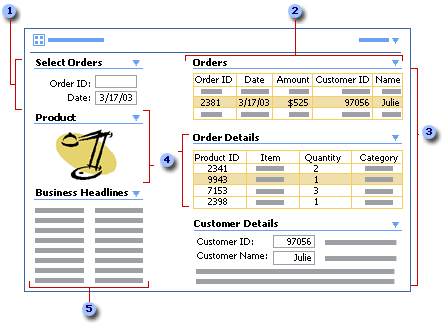
1 Look up an order by Order ID number or, in this case, the Order date.
2 Display all orders by date.
3 Select the correct order, based on the customer's name, and look up the order details as well as the customer details.
4 Select a line item in the order (in this case, the lamp) and display a product picture to confirm the customers question.
5 Scan for late-breaking business news pertinent to the customer's order.
 About Web Parts and Web Part connections
About Web Parts and Web Part connections
A Web Part is a modular unit of information that has a single purpose. Examples of Web Parts are:
The List View Web Part Makes lists on your site available to a Web Part Page.
The Content Editor Web Part Displays unstructured Web content, such as text, tables, or images.
The Image Web Part Displays a picture you specify, or connects to another Web Part that provides the picture.
The Form Web Part Displays a form you can use to enter text, and then use that text to filter columns in a connected Web Part.
An additional feature of Web Parts is the ability to easily connect them together by passing data between them and synchronizing their behavior. By connecting Web Parts, you can manage data in dynamic and interesting ways. Traditionally, the chore of connecting sets of data from different data sources has not been easy and has often required programming skills. But with Web Parts, making data connections is as simple as using menu commands. By connecting Web Parts, you can, for example, present data from two Web Parts in alternate views, perform related calculations between two Web Parts, and filter a Web Part using values from another Web Part — all on one Web Part Page.
 Web Part Pages are easy to work with in many ways
Web Part Pages are easy to work with in many ways
Web Part Pages are designed to be easy to:
Create You create and access Web Part Pages in much the same way as you do any document or Web page in Microsoft Windows SharePoint Services. Using a browser, you open a simple form to name a Web Part Page, choose a standard template for organizing the layout of the page, and store it in a document library. Once created, Web Part Pages automatically inherit the theme of your site. Using a Windows SharePoint Services—compatible HTML editor such as Office FrontPage 2003, you can make advanced modifications to a Web Part Page, such as customizing a theme, modifying a template, or making a Web Part connection between different pages.
Design Using just your browser and the Web Part Page tool pane, you can quickly locate a Web Part from a Web Part gallery, import a Web Part from your computer, add a Web Part to the page, arrange Web Parts in one or more zones on the page, modify various common properties available to all Web Parts, and modify custom properties unique to each Web Part. Iteratively designing and viewing changes is simple and fast.
Deploy Close the tool pane to browse the Web Part Page and make sure it's working the way you want. No complex installation is required to make it available. Just send a hyperlink of the Web Part Page in e-mail when you finish creating or changing it to notify all users who have appropriate permission.
Use Web Part Pages are as easy to use as any Web page. You can access the same Web Part Page from your office or home. Other site Web Part Pages, such as the home page, the Document Workspace site, or the Meeting Workspace site are also available for you to modify.
Share You can quickly make unique instances of a Web Part, save these changes to a compact, portable Web Part Description file (.dwp), and then send this file via e-mail to other users. Other users can then import the Web Part to a Web Part Page, and site administrators can upload them to Web Part galleries. Many instances of Web Parts can be shared by multiple users without performance degradation because Web Parts are designed to scale well.
Personalize You can personalize the Web Part Page or Web Parts on it by changing the layout of the page, adding or removing Web Parts, changing the size, position, or appearance of the Web Parts, hiding or removing unused Web Parts, or changing the content inside the Web Part — all without affecting other users. In addition, site administrators can make changes to Web Part Pages that all users should see, such as adding a company logo, locking in place a critical Web Part on a page, or protecting an entire page from being changed.
Secure Site administrators can control who can access a Web Part Page, view or modify the list data in a List View Web Part, personalize the page, add or delete Web Parts, or modify Web Part properties by using the standard rights and site groups in Windows SharePoint Services. Web Parts must be installed by the site administrator and be secured before they are made available to users.
Extend Developers inside and outside your enterprise can create custom Web Parts for installation at your site. More importantly, because Web Parts are designed with a set of standard connection interfaces, they can be developed by different developers, but still be easily connected by users. Web Part developers can use an extensive Windows SharePoint Services Software Development Kit available from the SharePoint Products and Technologies Developer Center. In short, Web Part Pages are a platform for Web software development.
 Ways to create and modify a Web Part Page
Ways to create and modify a Web Part Page
There are several ways to create and modify a Web Part Page.
The New Web Part Page form The most common way to create a Web Part Page is through the New Web Part Page form. After using this form to create a page, you can begin designing it right away in the browser. When you want to browse the page, you just close the tool pane.
An HTML editor Using an HTML editor compatible with Windows SharePoint Services, such as Microsoft Office FrontPage 2003, you can make advanced modifications to a Web Part Page, including the following:
A Programming environment Using a Windows SharePoint Services—compatible programming environment, such as Microsoft Visual Studio .NET, developers can exploit the full feature set of ASP.NET. A Web Part Page is an ASP.NET file (.aspx), and Web Parts are derived from Web Form Controls. To further enhance Web Part Pages, developers can create their own Web Parts that provide new functionality. Developers can also add custom properties to the Web Parts, custom builders in the tool pane for specialized user interfaces, and access to additional data sources unique to your enterprise through Web Part connections.
 Designing a Web Part Page in a browser
Designing a Web Part Page in a browser
Web Part Pages and Web Parts have a set of features and a consistent user interface that make them easy to create and customize in a browser.
 About the design features of a Web Part Page
About the design features of a Web Part Page
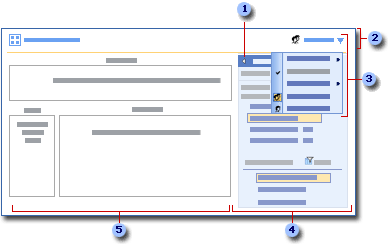
1 Click the arrow to widen or narrow the tool pane.
2 The Web Part Page title bar can contain a title, caption, description and Company logo or other image.
3 Use the Web Part Page menu to add and modify Web Parts, design the page layout, and switch between personal and shared views.
4 The tool pane has a dual-purpose; to locate and add Web Parts, and to modify various properties.
5 Templates are like a structured canvas used to organize Web Parts into zones.
 Accessing Web Parts stored in Web Part galleries through the tool pane
Accessing Web Parts stored in Web Part galleries through the tool pane
The tool pane makes it easy to locate and add Web Parts.
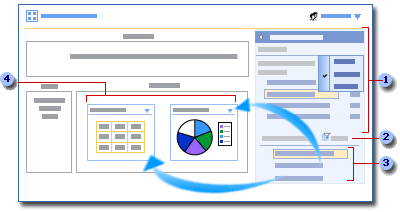
1 Browse and search for Web Parts in Web Part galleries or import them from a Web Part Description file (.dwp).
2 Click the Filter button to refine the list of Web Parts by lists, libraries, or other site-defined categories.
3 Most site list views are available through a List View Web Part.
4 Once you locate a Web Part, drag it into a zone on the Web Part Page.
 About the design features of a Web Part
About the design features of a Web Part
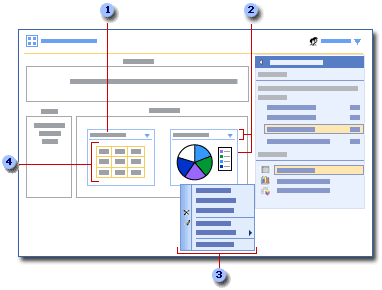
1 In some cases, you can click the title to display a detailed description of the Web Part.
2 The Web Part has a title bar and frame that contains the body of the Web Part.
3 Click the Web Part menu to do common tasks: minimize the Web Part, modify properties, connect Web Parts, get help, and so on.
4 The body of the Web Part contains list data, images, and other useful content.
 Viewing and modifying properties in the tool pane
Viewing and modifying properties in the tool pane
There are two types of properties. Common properties are shared by all Web Parts and organized into three sections in the tool pane: Appearance, Layout, and Advanced. Custom properties, which many Web Parts have, are unique to the Web Part. These properties are often displayed in a separate section above and sometimes below the common properties sections, but may also be displayed in a Miscellaneous section at the bottom of the tool pane.
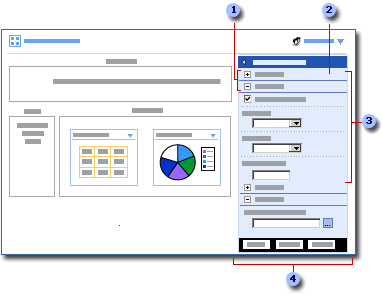
1 Click the plus (+) or minus (-) button to expand and contract each property section.
2 Modify custom properties for Web Parts (if they have them) in the custom properties section.
3 Modify common properties for all Web Parts in the Appearance, Layout, and Advanced sections.
4 Click OK or Apply to save your property changes.
Web Part Pages provide crucial benefits to you as a knowledge worker because: